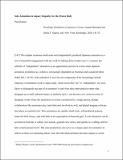Solo Animation in Japan: Empathy for the Drawn Body
Author(s)
Roquet, Paul
DownloadRoquet-2020-Solo Animation in Japan.pdf (678.9Kb)
Open Access Policy
Open Access Policy
Creative Commons Attribution-Noncommercial-Share Alike
Terms of use
Metadata
Show full item recordAbstract
This chapter examines small-scale and self-produced Japanese animations as a site of intensified engagement with the work of making drawn bodies move. Focusing on animations by Wada Atsushi, Mizushiri Yoriko, and Kuno Yōko, the chapter explores the afterlife of “independent” animation as an oppositional practice at a time when Japanese animation production as a whole is increasingly dependent on freelance and casualized labor. I introduce the term solo animation to designate works where the visual imagery onscreen is produced through the work of a single person. Solo animation is usually produced through great effort for little money, and with little to no expectation of financial gain. As this chapter argues, this turns solo animation into an important space for animators to reflect on the meaning of their own animating labor. The vulnerable forms of the bodies onscreen come to register external pressures shaping the practice of contemporary animation, including the industrial demands of the animation industry itself. In the process, these drawn bodies become a site of empathy for both animators and audiences alike.
Date issued
2020-08Department
Massachusetts Institute of Technology. Program in Comparative Media Studies/WritingJournal
Routledge Handbook of Japanese Cinema
Publisher
Routledge
Citation
Roquet, Paul et al. "Solo Animation in Japan: Empathy for the Drawn Body." Routledge Handbook of Japanese Cinema, edited by Joanne Bernardi and Shota T. Ogawa, Routledge, 2020.
Version: Author's final manuscript
ISBN
9781315534374